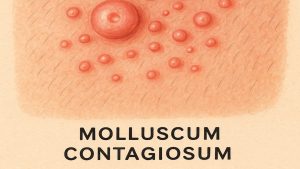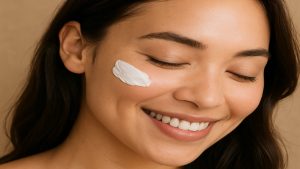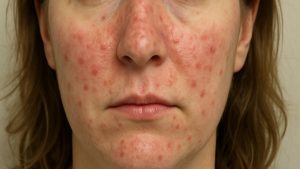- Albinism reduces or removes melanin production
- Oculocutaneous albinism affects skin, hair, eyes
- Ocular albinism mainly affects vision
- Sun protection prevents UV damage risk
- Support & awareness improve quality of life
Albinism is a rare inherited condition characterised by reduced or absent melanin in the skin, hair, and eyes. This pigment deficiency influences appearance, sun sensitivity, and vision.
This article explains what causes albinism, its main subtypes, and how those affected can protect their skin and wellbeing.

The Role Of Melanin
Melanin is a natural pigment made by melanocytes in the skin, hair, and eyes. It protects against ultraviolet (UV) radiation by absorbing and dispersing harmful rays that can cause sunburn or cell damage [1,7].
Genetic mutations that impair melanin synthesis lead to albinism. Without melanin, the skin is lighter, the eyes are more sensitive to sunlight, and the risk of UV-related health issues rises [1,7].
Melanin is also vital for visual development. Its absence can cause structural and functional eye changes, such as reduced acuity and light sensitivity [2,6,8].
Understanding melanin’s protective and developmental roles highlights why people with albinism require both sun protection and specialised eye care [1,7].
Types & Causes Of Albinism
Albinism occurs due to mutations in genes controlling melanin production. The two main forms are oculocutaneous albinism (OCA) and ocular albinism (OA) [1,2,8].
OCA affects skin, hair, and eyes, while OA primarily involves the eyes. OCA usually follows an autosomal recessive pattern, meaning both parents must carry the gene. OA is often linked to the X chromosome and more common in males [2,8].
Carriers usually have no symptoms but can pass the gene to their children. Genetic counselling can help families understand inheritance risks and available testing options [2,8].
Signs, Symptoms & Subtypes
Common Features
OCA presents with a range of visible and visual symptoms [2,8]:
- Pale skin: Burns easily and does not tan, requiring careful sun protection [1,5,7]
- Light hair: Colour ranges from white to light brown depending on residual melanin [1,2,8]
- Visual impairments: Nystagmus, photophobia, and reduced vision are common [6,7,8]
These features can impact confidence, daily function, and independence, especially when vision support is limited [6,8].
OCA Subtypes
Each OCA subtype corresponds to specific gene mutations and melanin levels.
- OCA1A: Complete absence of melanin
- OCA1B: Partial melanin development over time [2,8]
Recognising subtypes supports accurate diagnosis and management planning.
| Symptom | Description |
|---|---|
| Pale skin | Very light skin that burns easily and does not tan [1,5,7] |
| Light hair | Ranges from white to light brown due to reduced melanin [1,2,8] |
| Visual impairments | Includes nystagmus, photophobia, and reduced acuity [6,7,8] |
Table 1: Common symptoms and characteristics of OCA
Ocular Albinism (OA)
OA affects the eyes with minimal change to skin or hair colour. Symptoms often include [6]:
- Nystagmus or involuntary eye movements
- Photophobia or light sensitivity
- Translucent irises that appear pink or red
Treatment focuses on improving visual comfort through corrective lenses, tinted glasses, or assistive devices [6].
Albinism Across Populations
Albinism affects individuals of all ethnic backgrounds. However, lighter pigmentation may cause social challenges and misunderstanding in some communities [3,5].
Education and awareness help correct myths and reduce stigma. Advocacy groups and public health initiatives play key roles in improving inclusion and protection [5].
Sun Protection & Sensitivity
Because melanin is reduced or absent, people with albinism are more prone to sunburn and UV damage [1,3,7]. Proper protection prevents photoaging and reduces cancer risk.
| Measure | Description |
|---|---|
| Broad-spectrum sunscreen | SPF 30 or higher, reapplied regularly outdoors [1,3,7] |
| Protective clothing | Use long sleeves, hats, and UV-filter sunglasses [1,3,7] |
| Seek shade | Avoid midday sun and limit prolonged exposure [1,3,7] |
Table 2: Essential protective measures for albinism
Sun-safety education for children with albinism helps instil lifelong protective habits [1,3,7]. Schools, parents, and healthcare providers can support early awareness and ensure accessibility to suitable skincare and eye care [3,5].
Social Impact & Support
Living with albinism may involve emotional strain and social discrimination. Stigma can affect mental health and quality of life [5].
Empathy, education, and supportive communities foster acceptance. Counselling and peer networks can provide reassurance and strengthen self-esteem [5].
Albinism In Animals
Albinism also appears in animals, including reptiles, birds, and mammals. For example, albino pythons have distinctive pale skin and red eyes. Research into animal albinism enhances understanding of pigment biology and human genetics [5].
Promoting Awareness & Advocacy
Awareness efforts help build inclusive attitudes and improve health outcomes.
Key approaches include:
- Education: Distributing factual information about albinism [5]
- Advocacy: Supporting research and equality initiatives [5]
- Community engagement: Hosting awareness events and media campaigns [5]
These actions promote empathy, challenge stereotypes, and protect human rights.
Skin Care For Albinism
Although skincare cannot change genetic pigment loss, it supports comfort and protection. Gentle, fragrance-free products, broad-spectrum sunscreen, and consistent moisturising maintain skin barrier strength [1].
Monderma provides prescription skincare for general information purposes only. These formulations are not indicated for genetic pigment disorders such as albinism but can support overall skin health under professional guidance.
Conclusion
Albinism is a lifelong genetic condition affecting pigmentation, vision, and social experience. Through education, advocacy, and strong sun protection, individuals with albinism can protect their health and wellbeing while promoting inclusion and awareness.
You can explore Monderma’s free online consultation to discover tailored skincare options for sensitive skin. Sharing this article helps raise awareness and understanding of albinism.
Content is for informational purposes only. Monderma treatments are prescribed following consultation. Results and timeframes can vary. Use as directed by your prescriber.
Bibliography
- NHS. Albinism. NHS Conditions, 2023.
- Grønskov K., Ek J., Brondum-Nielsen K. Oculocutaneous Albinism. Orphanet Journal of Rare Diseases, 2007; 2:43.
- Lund P.M., Taylor J.S. Lack of Adequate Sun Protection for Children with Oculocutaneous Albinism in South Africa. BMC Public Health, 2008; 8:225.
- British Association of Dermatologists. Squamous Cell Carcinoma. 2022.
- Marçon C.R., Maia M. Albinism: Epidemiology, Genetics, Cutaneous Characterisation, Psychosocial Factors. Anais Brasileiros de Dermatologia, 2019; 94(5):503-520.
- Kruijt C.C., de Wit G.C., Bergen A.A., Florijn R.J., Schalij-Delfos N.E., van Genderen M.M. The Phenotypic Spectrum of Albinism. Ophthalmology, 2018; 125(12):1953-1960.
- Brenner M., Hearing V.J. The Protective Role of Melanin Against UV Damage in Human Skin. Photochemistry and Photobiology, 2008; 84(3):539-549.
- MedlinePlus. Oculocutaneous Albinism. Genetics Home Reference, 2021.
Find your perfect skincare formula
Takes less than 2 minutes – see what your skin needs
Get Custom Formula













